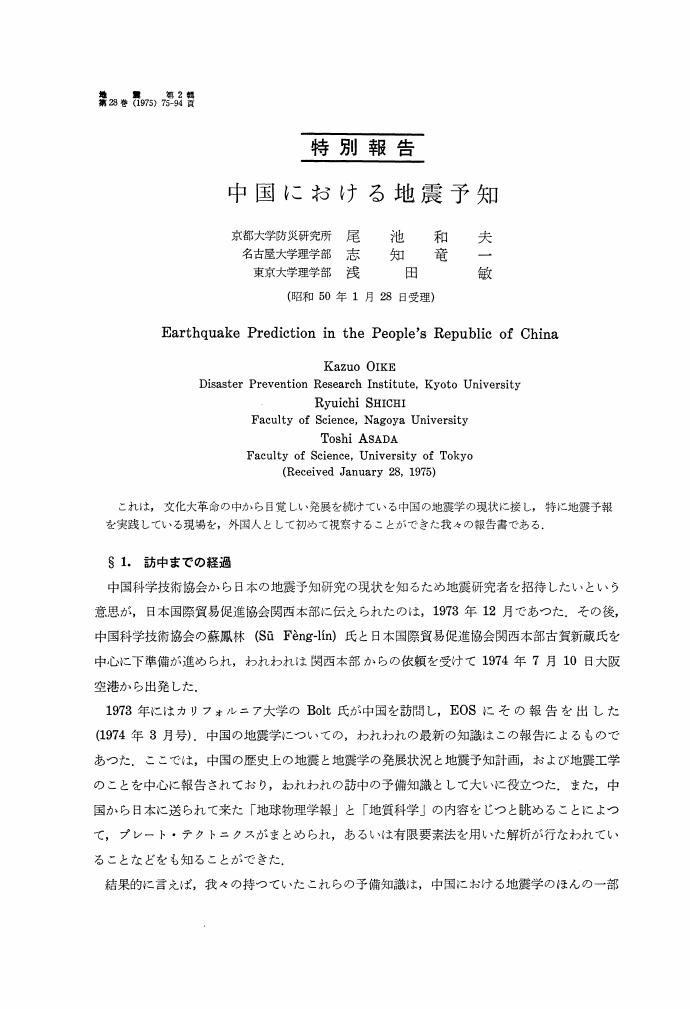1 0 0 0 OA 犬山における地殻変動の連続観測
- 著者
- 飯田 汲事 志知 竜一 松浦 宏
- 出版者
- 日本測地学会
- 雑誌
- 測地学会誌 (ISSN:00380830)
- 巻号頁・発行日
- vol.14, no.4, pp.144-155, 1969-09-30 (Released:2011-07-05)
- 参考文献数
- 7
After the installation of the instruments: Water-tube Tiltmeter; Ishimoto silica clinograph; silica extensometer, at Inuyama Crustal Movement Observatory in 1966, the continuous observation of crustal deformation has been carried out. This report is the results of 14 months- observation. It was found that the maximum principal strain was 0.6×10-6 in extension and 0.5×10-6 in contruction; areal dilatation was -0.2- +0.6×10-6 and maximum shearing strain was 1.6×10-6. The changes in inclination was also found to be in the order of 1.8×10-6 rad. The direction of extension of the principal strain seems to be corresponding to the geologic structure in Inuyama district. The change in areal dilatation has a reciprocal to that of the maximum shearing strain . The noise accompaning precipitation is comparatively large compared with the secular change in crustal deformation. However, the foundamental clue to the removal of this noise effect on crustal deformation was obtained. The mechanism of this noise appearance is presumably understood by considering the geologic structure in this area.
1 0 0 0 IR 雲仙火山地域の重力異常
- 著者
- 小室 裕明 志知 竜一 舌間 洋二
- 出版者
- 島根大学
- 雑誌
- 島根大学地球資源環境学研究報告 (ISSN:13439774)
- 巻号頁・発行日
- vol.19, pp.97-100, 2000-12-25
A Bouguer gravity anomaly map of the Unzen volcanic area founded on 590 gravity stations suggests the following volcanic structures:1.The gravitational Unzen graben shows a linear north rim along the Chijiwa fault.However,the gravitational south rim does not coincide with the Futsu fault which is the topographical south rim of the Unzen graben.2.The source of a low gravity anomaly in Tachibana-wan Bay has been considered as mass deficiency of caldera origin,but it may in fact be due to the emplacement of a large magma body.
1 0 0 0 OA 中国における地震予知
- 著者
- 尾池 和夫 志知 竜一 浅田 敏
- 出版者
- 公益社団法人 日本地震学会
- 雑誌
- 地震 第2輯 (ISSN:00371114)
- 巻号頁・発行日
- vol.28, no.1, pp.75-94, 1975-04-10 (Released:2010-03-11)
- 参考文献数
- 4
1 0 0 0 IR 犬山で観測された岐阜県中部地震 1969年9月9日に伴う地殻歪に関する二,三の考察
- 著者
- 志知 竜一 飯田 汲事 山内 常生
- 出版者
- 東京大学地震研究所
- 雑誌
- 東京大学地震研究所彙報 (ISSN:00408972)
- 巻号頁・発行日
- vol.48, no.6, pp.1241-1249, 1970-11
A remarkable strain step was recorded by the strainmeter at the Inuyama Crustral Movement Observatory which is located at a distance of about 48km from the epicenter of the Gifu earthquake of September 9, 1989, with the magnitude of 6.6. At the same time a rapid increase of discharged water in the observational gallery was also observed. These phenomena were also observed at the time of the off Nemuro (Hokkaido) earthquake of August 12, 1969, with the magnitude of 7.8. In the case of the off Nemuro earthquake the epicentral distance was about 1200 km. These strain steps and the abnormal increase of discharged water at the time of earthquakes were taken into consideration for the analysis of the crustal deformation accompanied by earthquakes and principal strains obtained from the calculations are listed in Tables 1 and 2, respectively.
